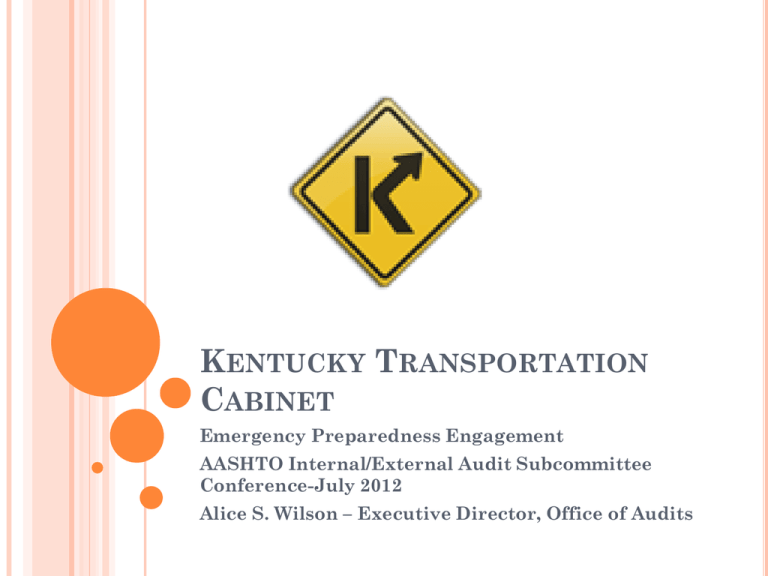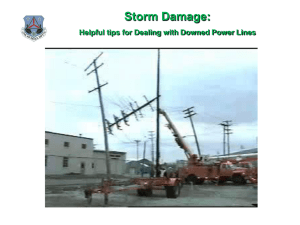Kentucky Transportation Cabinet - AASHTO
advertisement

KENTUCKY TRANSPORTATION CABINET Emergency Preparedness Engagement AASHTO Internal/External Audit Subcommittee Conference-July 2012 Alice S. Wilson – Executive Director, Office of Audits JANUARY 2009 ICE STORM In January 2009, an Ice Storm blanketed Kentucky JANUARY 2009 ICE STORM Many roads were covered not only in snow and ice, but also trees, and lots of them First priority was people Second priority was clearing roads No electricity, satellite phones in district offices not working, emergency generators were needed On February 5, 2009, FEMA declared a “Severe Winter Storm and Flooding” disaster for certain areas of Kentucky affected by the storm KYTC entered into land leases for the first time to handle the 15 million plus cubic yards of vegetative debris JANUARY 2009 ICE STORM KYTC crews worked diligently to respond as quickly as possible There was a LOT of vegetative debris to handle When acting quickly, some things fall through the cracks so to speak Contractor issues crept up OIG conducted an investigation as a result of complaints raised by contractor As of August 2011, KYTC spend $146 million as a result of this disaster and received $45 million in reimbursements from FEMA and FHWA. JANUARY 2009 ICE STORM The KYTC Division of Incident Management issued an “After Action Review” which included the following problems: No communications available between county, district and central office when satellite, cell and twoway radios didn’t work All locations did not have generators No fuel for equipment and personnel due to electricity outage Additional training for employees needed FEMA provided inconsistent guidance JANUARY 2009 ICE STORM-OIG INVESTIGATION On January 21, 2011, KYTC OIG issued their investigative report which included: Deficiencies in debris management and site selection Contract term violations Deficient contract oversight OIG report included recommendations that KYTC should: Develop a debris management plan Make contract overseers aware of their responsibilities, including vendor surveys Identify training needs for district personnel, including ethics OIG INVESTIGATION The investigation substantiated flagrant deficiencies of contractor conduct by Contractor and through its Subcontractor and included: Billing KYTC for more hours than equipment actually operated Double billing Forged operator signatures on equipment logs The investigation revealed contract oversight in district was not conducted or was insufficient. The Contractor and Sub committed fraud with improper billing, falsification of equipment logs and improper use of equipment. OIG INVESTIGATION Contractor flagrantly billed KYTC for inflated operational hours of heavy equipment at Debris Management Site (DMS), particularly in one county. District officials were aware of the practice. District officials were aware of and ignored the flagrant and common practice of contractor equipment operators improperly forging signatures on TC 71-214 Daily Report on Use of Rented Equipment. District officials failed to diligently review and sign TC-214 Daily Report on Use of Rented Equipment, which is used as the basis for vendor invoicing to KYTC. An estimated 2,500 vendor submitted forms were reviewed by OIG investigators and 173 were missing the CDE or authorizing agent signature. A mere cursory review of all the forms as they were submitted for payment would have alerted the reviewer that the same person had obviously signed for multiple operators. OIG INVESTIGATION Inadequate or no monitoring at some DMS sites. Issues with improper rental equipment use would have been detected with diligent monitoring efforts. District senior officials were unfamiliar with specifications and other terms of applicable contracts used in debris operations. KYTC relied on equipment rental master agreements to manage debris at DMS. Work performed by a vendor under this type of contract is typically for general maintenance of roadway areas and the vendor is paid on an hourly rate for equipment and operator. This type of contract (time and materials contract) is well suited for short term work and would be practical for use to facilitate movement of debris during the response phase of the ice storm disaster, but not for long term debris management. KYTC should have avoided this type of contract and solicited for a contract specifically for managing debris at DMS. FEMA deems time and material contracts to be the least preferred type of contract for debris operations. OIG INVESTIGATION OIG sent their Report of Investigation to the Commonwealth’s Attorney for review and determination of action. On March 8, 2010 meetings were held at the Commonwealth’s Attorney’s office Settlements, totaling $234,384.20 in payment reduction and repayment were tentatively reached in which Contractor agreed to reduce pending payment due from KYTC by $194,384.20, and Subcontractor agreed to remit $40,000 to KYTC. More could have probably been recouped had not KYTC employees been involved in some of the wrong doing JANUARY 2009 ICE STORM KYTC Secretary was concerned with results of emergency response as well as OIG report, so asked me if Internal Audit could perform a review to see what improvements had been made since the January 2009 Ice Storm and what else was needed for improvement On April 14, 2011 we had an entrance conference with several KYTC staff and started the engagement Purpose of the engagement was to look at events during the 2009 Ice Storm, what procedures we currently have in place and what procedures we should add to our current emergency preparedness policies. EMERGENCY PREPAREDNESS ENGAGEMENT We developed an audit program which included: Review of applicable federal and state regulations Interviews from various personnel in Purchases, Maintenance, Accounts, Legal Services, Budget, Human Resources, OIG and District personnel Review of KYTC’s draft policies and procedures Survey completed using “survey monkey” (sent to 171 KYTC employees and had 74 responses!) Review of FEMA, various state DOT emergency plans and the Kentucky Emergency Operations Plan Review of private land lease agreements Review of expenditures, reimbursements, and debris quantities in relation to the 2009 Ice Storm EMERGENCY PREPAREDNESS ENGAGEMENT KYTC seeks federal reimbursement from FEMA, FHWA Emergency Relief and USDA-NRCS (Natural Resources Conservation Service) Different Federal agencies have different rules and thresholds to meet, as well as documentation requirements KYTC polices were deficient and not detailed enough KYTC management in different divisions had differing views on what was required, who was responsible for what, etc. Other states have plans in place, but they all vary EMERGENCY PREPAREDNESS ENGAGEMENT One of biggest issues: Land Leases 15 million cubic yards of debris No DMS selected ahead of time KYTC did not have authority to enter land leases, only our Finance and Administration Cabinet (FAC) has authority to do this KYTC Legal Services approved a “land lease agreement” after FAC granted approval to KYTC to enter into land leases – however no instructions provided regarding how DMS selected, by who, etc KYTC paid $500 per acre per month for usage of land Total expenditures for land leases: $2.7 million. District in question spent .37 per cubic yard for land leases, next district over only spent .09 per cubic yard and had twice the debris EMERGENCY PREPAREDNESS ENGAGEMENT From survey we learned that: 57% did not feel there should be an additional contact for an emergency coordinator. 73% reported there were no pre-approved Debris Management Sites (DMS) in their county. 53% reported state owned property was not considered for a DMS site. 10% reported the use of emergency purchase procurement procedures prior to or in place of existing contracts. 99% reported they understood the importance of proper documentation. 18% reported chipping/mulching debris was better than burning, or the only experience they had. 41% acknowledged positive steps have been taken to correct past problems or barriers. 96% reported documentation procedures in various ways such as digital cameras, load tickets, timesheets, and the Operations Management System (OMS). Various responses were given on procedures to follow in an emergency with 19% reporting they would call someone else, do what they were told, or it would depend on the emergency. 70% reported areas where the Cabinet is not ready or prepared for in another emergency such as staffing, equipment, communication, earthquakes, and pre-approved debris management sites. EMERGENCY PREPAREDNESS ENGAGEMENT After the 2009 Ice Storm, KYTC made the following improvements: Requested and received delegated authority from the Finance and Administration Cabinet to let emergency contracts for roadway clearance, debris removal and disposal, site reclamation and monitoring services. Procured state and district wide contracts for equipment rental with and without operators. Procured Disaster Emergency Debris Monitoring Service contract with VENDOR that provides personnel to monitor and properly document the debris removal and disposal activities across the state during a disaster. EMERGENCY PREPAREDNESS ENGAGEMENT Recommendations included: Maintenance should develop Emergency Preparedness Plan (In Process) Maintenance should ensure training is provided on FHWA, FEMA and NRCS policies, programs, regulations, guidelines and documentation requirements (we established “District Disaster Coordinators” and had them, along with a backup attend FEMA/FHWA week long training, reminders given at Section Engineers meeting also) Each district should have an emergency team that includes a district disaster coordinator, a backup and someone from the financial area (District Disaster Coordinators) Districts should identify debris staging, reduction, and disposal sites in each county to expedite debris removal and subsequent volume reductions and disposal actions (considering ownership, size, location and environmental/historic concerns) (In Process) EMERGENCY PREPAREDNESS ENGAGEMENT Recommendations (cont.) Maintenance and Districts should maintain contact list of central office, district, local agencies and non-profits with the roles and responsibilities of each contact. (In Process) Several divisions should develop a communication plan to ensure that communication lines remain open Several divisions should develop a plan to ensure fuel is available for equipment in disaster areas (Done) Maintenance should develop a process to track cabinet force account equipment use and time and include appropriate document retention requirements KYTC should ensure Plan is communicated to all appropriate personnel (will when Plan finalized) Applicable KYTC manuals should be updated EMERGENCY PREPAREDNESS ENGAGEMENT Internal Audit shared several examples of emergency preparedness plans and debris management plans with applicable KYTC personnel KYTC has a central office employee that is the “Master of Disaster” who we hope stays, but should be cross training another employee EMERGENCY PREPAREDNESS The old saying is true…. “An ounce of prevention is worth a pound of cure.” Since 1957, Kentucky has had a total of 65 major disasters declared Since the 2009 Ice Storm, we have had 6 plus major disasters Must be prepared for anything that comes our way – Snow, Ice, Tornado, Flooding, Winds, etc. Alice S. Wilson, CPA Executive Director Kentucky Transportation Cabinet Office of Audits 200 Mero Street Frankfort, KY 40622 502-564-6760 ext.3615 Alice.Wilson@ky.gov http://transportation.ky.gov/Audits/Pages/default.aspx








